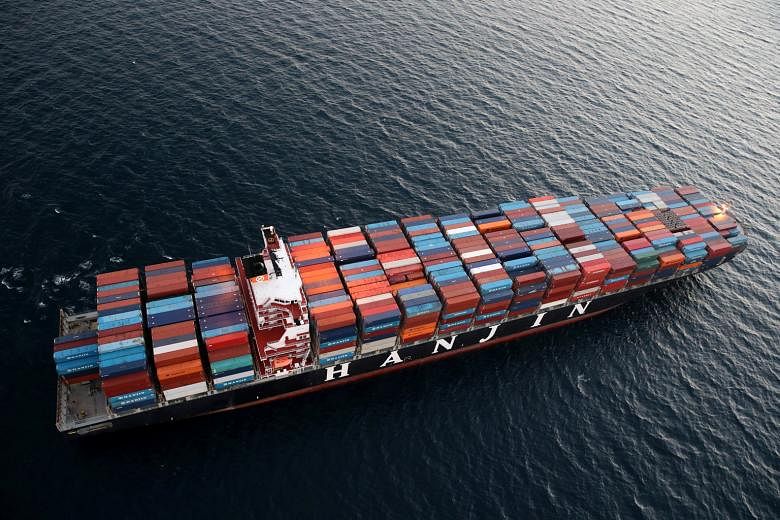The unprecedented collapse of South Korea's Hanjin Shipping, until recently the world's seventh largest container line, has thrown the global shipping industry and supply chains into massive disarray.
Dozens of Hanjin ships carrying cargo worth US$14.5 billion (S$19.7 billion) were left out at sea when the shipping giant filed for receivership last month, after creditors halted financial support.
Some of these ships have been denied entry into ports, while others have refused to dock on fears of being seized by creditors. The marooned cargo could spell trouble for retailers ahead of Christmas.
For Singapore, which is intricately linked to the global maritime trade, industry observers say it is likely the port will emerge relatively unscathed. It is the smaller firms down the supply chain that could take a harder hit.
The bigger question that remains is what the protracted downturn - of which Hanjin has emerged as the biggest casualty - means for Singapore in the longer run.
SOME PAIN FOR NOW
When Hanjin declared bankruptcy, competing carriers Maersk Line and Mediterranean Shipping quickly responded by offering new services to fill the capacity gap.
The fierce competition among carriers, coupled with more than enough capacity, means it is unlikely port volumes here will be affected over the longer term, says Ocean Shipping Consultants director Jason Chiang. "It's not like the cargo can take another route... There could be delays or mothballing of cargo at certain ports, but it will get cleared."
Mr Andy Lane, partner at CTI Consultancy, notes that Hanjin, as part of the CKYHE alliance, had all of its South-east Asian hub business in Singapore. "Some former Hanjin customers will likely ship some cargo on other lines that call at other ports, so there could be some volume decline for Singapore, although this will be extremely low."
Hanjin also had slot swop agreements with over 20 other ship operators. This means that a shipper, such as a freight forwarder, might have cargo on Hanjin vessels which is likely now stuck or diverted, and "certainly delayed", adds Mr Lane.
Singapore's High Court has temporarily frozen all Singapore proceedings against Hanjin and its local subsidiaries, pending a full hearing for all parties here on whether the freeze should continue until January. This means Hanjin ships can dock in Singapore without being seized by creditors. Two Hanjin vessels called and offloaded at the Tanjong Pagar Terminal last week.
Still, cost and who is going to be responsible for it remains a primary issue, notes Mr Jonathan Oon, director of the shipping department at TSMP Law Corporation.
"Even if there is an intention to move the ships, bunker and other suppliers will probably be wary in supplying the ships without any certainty of payment. Similarly for the containers, there are loading costs that have to be accounted for. The situation, for now, is probably going to be a standstill," says Mr Oon.
The pain is already trickling down the supply chain. Mr Eric Chan, director of dried goods importer Yew Ming Trading, tells The Straits Times the company has a container of barley still stuck on a Hanjin vessel, but he has no details on where the ship is, or what will happen to his goods. It was supposed to have been delivered on Sept 6.
"Nobody seems to know what is happening or what is going to happen," says Mr Chan, adding that his inquiries to shipping companies have gone unanswered. "It's not a high-value item, but that one container is our supply to all of our customers in Singapore. We could lose some of the customers we've spent years establishing relationships with, over just an incident like this."
Mr Chan, who has ordered another container of barley to replace the stranded stock, adds: "Ours was just one container. Imagine those with multiple containers - the disruption and costs will be massive. In a situation like this, SMEs (small and medium-sized enterprises) like us will suffer the most."
OVERCAPACITY: THE UNDERLYING CRISIS
Hanjin's malaise is but symptomatic of the wider crisis the global shipping industry has been mired in since around 2009, as global trade began to wane.
Cost-cutting has become a priority. Some carriers have reduced sailings, while others have idle capacity. Consolidation is taking place as the top players look to compete on scale, with CMA CGM's $3.38 billion buyout of Singapore's Neptune Orient Lines as the biggest to date.
But analysts agree the most pressing problem remains the bloated state of the industry, exacerbated by the advent of mega vessels. These vessels are typically able to carry 13,400 to 22,000 20-foot equivalent units (TEU) of cargo.
VesselsValue head analyst Toby Yeablsey notes the appetite for larger container ships has grown substantially in the past few years due to their cost-saving ability - "the more goods you can move in one go, the cheaper each unit becomes to ship".
"Also, the top container companies are always fighting one other for market share of global trade. So they see these vessels as the perfect way to get a leg up on the competition," he says.
Clearly, then, scrapping would be the way to go. Mr Lane notes this is under way - with the year set to see the "highest ever" carrying capacity being scrapped, at 500,000 TEUs - but not at a rate that is fast enough.
"That number comes from a total global fleet of 20 million TEUs, so it is not significant," he says, adding that by contrast, 3.5 million TEUs will be added to the fleet over the next two to three years, based on the current order book. This means the capacity glut is far from easing.
KEEPING HEAD ABOVE WATER
In light of all that, is Singapore's move to invest so heavily in gearing up for an era of mega vessels justified? Mr Chiang's answer is yes.
"There's no telling what sort of vessels will be used in the next 30 years, or what other means cargo will be transported by, but it is important that Singapore is taking steps to 'future-proof' its assets."
Port operator PSA is expanding the Pasir Panjang Terminal in a $3.5 billion project to be completed next year, while a new mega port in Tuas is set to house all container operations from the next decade. The new port will allow Singapore to handle up to 65 million TEUs a year, up from 40 million units today, and will be able to cater to mega ships and the complex needs of alliances.
Mr Victor Wai, lead analyst for ports at Drewry Financial Research Services, says: "The central idea of deploying mega vessels is to have economies of scale in transporting cargo. It keeps liners competitive in the current economic landscape. Scale is important for liners, and to keep up with the trend, Singapore needs to have the critical mass so as to better service its customers. So the Tuas mega port remains very much relevant in this context."
Mr Wai adds that the growth in container vessel size also increases the dependency on transhipment ports like Singapore, allowing it to remain as an important transhipment hub for the region.
Notably, while port handling charges in Singapore are known to be much higher than its neighbouring peers', an industry source tells The Straits Times that Singapore's port does offer competitive prices.
"The charges for shipping lines with substantial volumes here, in particular, are "definitely competitive" he says, although declining to reveal further details. "Given today's market conditions, cost is the most important factor that the port has to compete on. It has to be able to offer a cost-competitive solution in order to secure its future."
Mr Lane expects to see more pain ahead for the shipping industry, and for longer, amid sluggish global growth. Carriers with small to medium-sized fleets which cannot rely on government bailouts are going to bleed cash for years to come, he says. "Alliances can ease the pain, but they do not nullify it totally. There might be some fire sales, and if not, then further bankruptcies."
That said, industry leader Maersk Line is moving ahead with digitisation as it retrofits its ships with equipment to collect data that will help reduce costs and optimise efficiency - a move likely to set a precedent for the rest of the industry.
And at least one local shipping agency is seeing a silver lining amid the gloom. Mr Ashok Batura, managing director of Sinoda Shipping Agency, says it is providing more services for the laying up of ships. It is also diversifying into the logistics and haulier business to cope with the downturn.
"It's not big, but it's still a form of revenue. The shipping industry is in a slumber right now and we have to do something to survive," he says.
Jacqueline Woo


